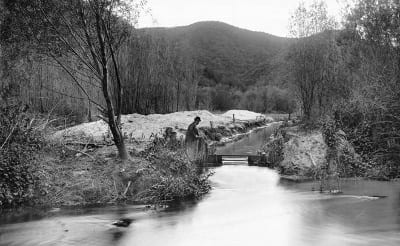The Los Angeles River Before It Became A Concrete Channel (It’s Not What You Think)
A short piece in Los Angeles Magazine paints a picture of a Los Angeles River very different from the concrete jungle it’s become today:
Before human civilization transformed it, the L.A. River flowed in some places through grassy oak woodland. In others it coursed through a dense forest of willows, cottonwoods, and sycamores. Steelhead trout swam through its currents, antelope and deer paused at its banks to drink, and grizzly bears ambled into its waters for food.
After a winter storm, the tame stream became a whitecapped fury. In the parched summer months, the river plunged below the surface where it encountered the porous soil of the Los Angeles Basin. But at the Glendale Narrows, shallow bedrock forced the stream aboveground, guaranteeing a year-round flow. In other places, where the parking lots of Beverly Hills, Compton, and Hollywood bake in the sun today, groundwater hydrology conspired with seasonal flooding to create a vast system of marshes, ponds, and other wetlands teeming with plant and animal life.
Today, the Southern California landscape has been transformed and its steelhead and other wildlife have suffered for it.
While we’re in the midst of trying to save what’s left, it couldn’t hurt to pause every once in a while to remember things as they really were.

(Photograph courtesy of the Title Insurance and Trust, and C.C. Pierce Photography Collection, USC Libraries)




